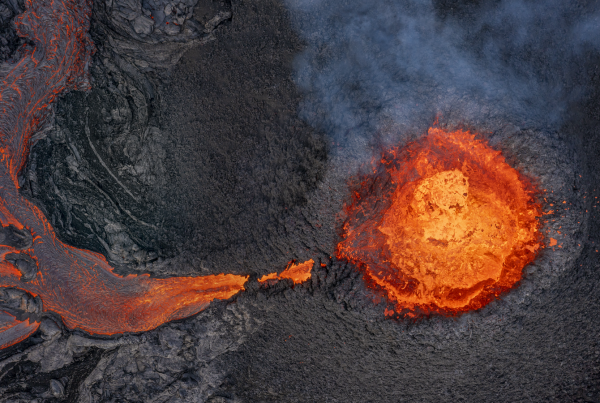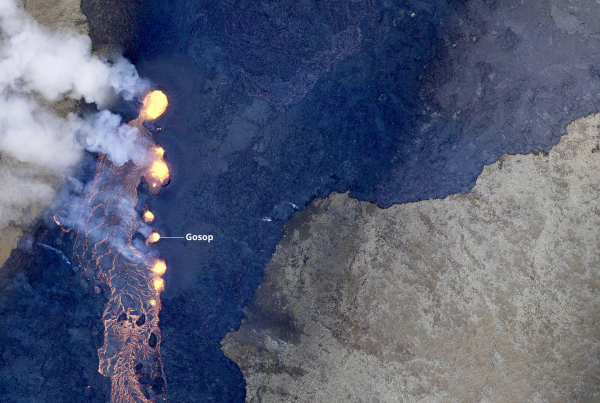Let’s begin with the most important question: Is this development dangerous to human lives? The short answer is currently NO.

The worst case scenario in the geological development taking place around Mt. Thorbjörn in Reykjanes, Iceland, is that it will lead to a volcanic eruption. In most cases, there would be no reaction to the events now taking place but due to the proximity to human habitation, all precaution is taken. So, what does it mean if there will be an eruption at this location?
What happens in case of an eruption
Volcanic eruptions take place regularly in Iceland, or on average every four or five years. Usually these eruptions make little more than local headlines and have no consequences. This also means that eruptions most people hear about are serious, dangerous eruptions. They don’t make the news unless there are consequences. Like Mount St. Helens in 1980 in Washington State, the recent outburst on Whakaari/White Island in New Zealand or the infamous Eyjafjallajökull eruption in Iceland in 2010 which grounded flights all over Europe. Each one of these eruptions are of very different character and to most it is a surprise to hear that there have been two eruptions in Iceland since Eyjafjallajökull in 2010, both of them larger than Eyjafjallajökull. And yet, they barely made the news.
Mount St. Helens
Mount St. Helens is a stratovolcano, like Mt. Vesuvius in Italy and Mt. Krakatá in Indonesia. These are steep volcanoes that can generate powerful explosions followed by extremely fast and hot pyroclastic flows. These are the deadliest types and the most infamous ones. And yet, most stratovolcano eruptions are relatively harmless, such as the almost constant eruptions in Mt. Etna in Sicily. Mt. Thorbjörn is NOT a stratovolcano and does therefor not pose any risk of an explosive eruption with superfast landslides, avalanches or pyroclastic flows. Eyjafjallajökull however is a stratovolcano.
Eyjafjallajökull
What made Eyjafjallajökull such a memorable eruption was the ashcloud. Due to the composition of the ashes and the fact that the eruption was subglacial it generated a light, air-born ash that could travel long distances in the atmosphere. The ash is what is most dangerous for jet engines and the reason planes were being grounded while further information was being gathered about the type of the ash and the spread. Mt. Thorbjörn is not subglacial and an eruption will therefor not create a similar kind of ash or be problematic to air traffic at longer distances. Even most subglacial eruptions generate heavier ash than Eyjafjallajökull did and hence do not pose the same risk to air traffic. Such as the subsequent Grimsvötn volcano eruption in Vatnajökull glacier in 2011. A much more powerful eruption than Eyjafjallajökull which caused considerable ash fall in the town of Kirkjubaejarklaustur in SE Iceland but had very limited effect on air traffic.
What to espect at Mt. Thorbjörn

Some known eruption sites close to Mt. Thorbjörn
What we can expect at Mt. Thorbjörn is a fissure eruption. A volcanic fissure is when a linear volcanic vent opens up, usually without any explosive activity. The vent is usually only a few meters wide but can be several kilometers long. These usually open up in the slopes of a volcano or even on flat plains. In the case of Mt. Thorbjörn the most likely place for the eruption is expected to be west of the mountain itself, and not in the mountain. Mt. Thorbjörn is not even a volcano as such. It is lava that was piled up above a subglacial fissure opening sometime during the last iceage. The lava currently covering the ground came up during a later fissure eruption 2500 years ago on the east side of the mountain, and 800 years ago in Eldvörp on the west side, an area that is still very warm with a row of craters and steam coming from the ground. The same geothermal energy that heats all houses in the peninsula and provides the Blue Lagoon with it’s water.
Holuhraun

Few people have heard about the enormous Holuhraun eruption even though it was much bigger than Eyjafjallajökull. A very isolated eruption far away from any populated places. Photo by Ragnar Th.
A good example of a fissure eruption is the Holuhraun eruption north of Vatnajökull glacier in Iceland in 2014. Such eruptions can last for a long time and cause large lavaflows. Holuhraun lasted 6 months and produced a lava field of more than 85km2. The Holuhraun eruption was accompanied by daily earthquakes measuring up to 5 on Richter, much larger than the movement we are seeing around Mt. Thorbjörn.
What does a fissure eruption at Mt. Thorbjörn mean?
If you look at a geological map of the area you will see rows of SW-NE lines going through the landscape. These are created by previous fissure eruptions. Considering the pressure build up and the size of the earthquakes geologists expect that if these events lead to an eruption, it will be a relatively small one, only lasting a few days or weeks. A fissure eruption often has beautiful lava fountains, where glowing lava is thrown hundreds of meters in the air above the main vent. What we sometimes refer to in Iceland as a “tourist eruption” due to the relatively little danger it poses and ease of coming relatively close to it and view the magnificent forces of nature at play. That being said you should always keep a safe distance and never try to approach a volcanic eruption without an expert at your side. While fissure eruptions can be “cute” and pretty you can’t “pet” them.
Eruption close to Grindavík, The Blue Lagoon and Keflavik international airport
The biggest problem of a potential Thorbjörn eruption is the location. If the eruption starts where the inflation is the most, and therefore the most likely place, it will put the Svartsengi geothermal plant at risk as well as the Blue Lagoon spa and hotel, including their just opened new five star hotel. The mountain itself, Mt. Thorbjörn is likely to become a barrier protecting the town of Grindavik and divert the lava flow away from the town, as it is between the likely fissure location and the town. Furthermore, an eruption could potentially cut off supply lines to towns on the peninsula, including the international airport. That is fiber optic cables for telecommunications, electricity lines and water supplies, both hot and cold. The location of the eruption could therefor cause considerable material damages.
The airport is another concern. It has been stated that if an eruption starts the airport will be closed down immediately. This is a precautionary action while an evaluation is taking place on the size and impact of the eruption, in particular the impact on planes coming in for landing or takeoff. There are two other international airports in Iceland so there will always be the possibility of landing on one of those instead, or getting back home through those. So what it will cause is inconvenience. It can be mentioned that during the Eyjafjallajökull eruption in 2010 when all flights were cancelled in Europe, Iceland always had an open airport. In the few days the main airport was closed there was the option of using the alternative airports at Akureyri or Egilsstadir.

The magma accumulation under the Reykjanes Peninsula
Evacuation routes
Geologists estimate the magma to be currently at the depth of 3-4 km. By closely monitoring the depth of the earthquakes it should be possible to give a warning several hours before the magma reaches the surface, giving people good time to prepare any evacuation if needed. The evacuation areas and routes will of course depend on where the lava will reach the surface. The Blue Lagoon has roads going in two opposite directions from the facilities meaning there is always an open evacuation route if an eruption starts, even if it is right next to or on the road. The same goes for the town of Grindavik. There are roads leading to the east, west and north from town as well as a harbour open to the south. There are therefor always roads that will be open.
In the case of an emergency
In the case of an eruption an emergency text message will be sent out to all mobile phones in the region with information about where to go and what to do. It is therefor a good idea to put 112 as a contact on your phone with a bypass alert so that you will be sure to get the notification even though you have your phone switched to silent or night mode.
Setting up the “112 Iceland” app is also a good idea.
As always follow local news, the local MET Office and safetravel.is



